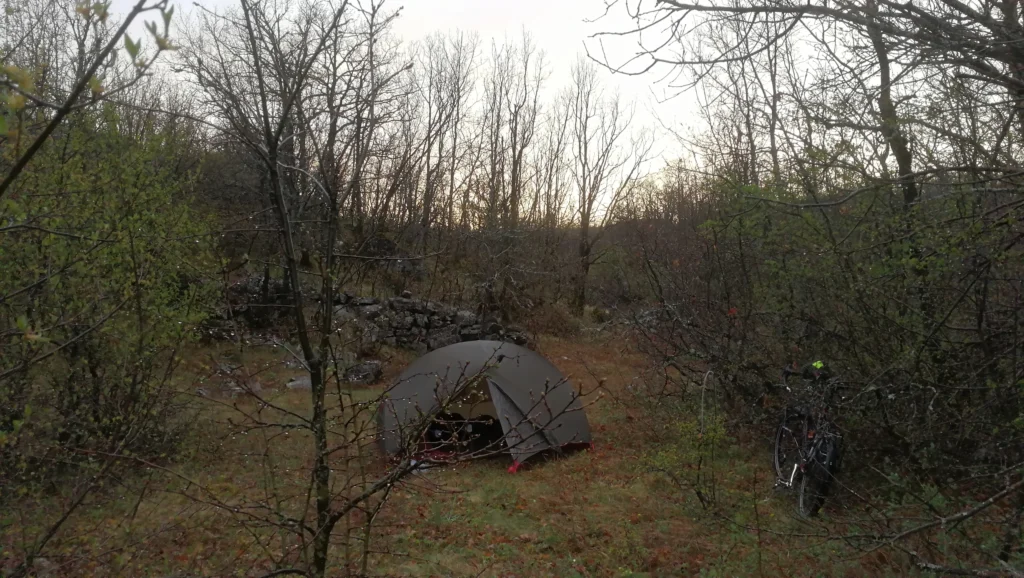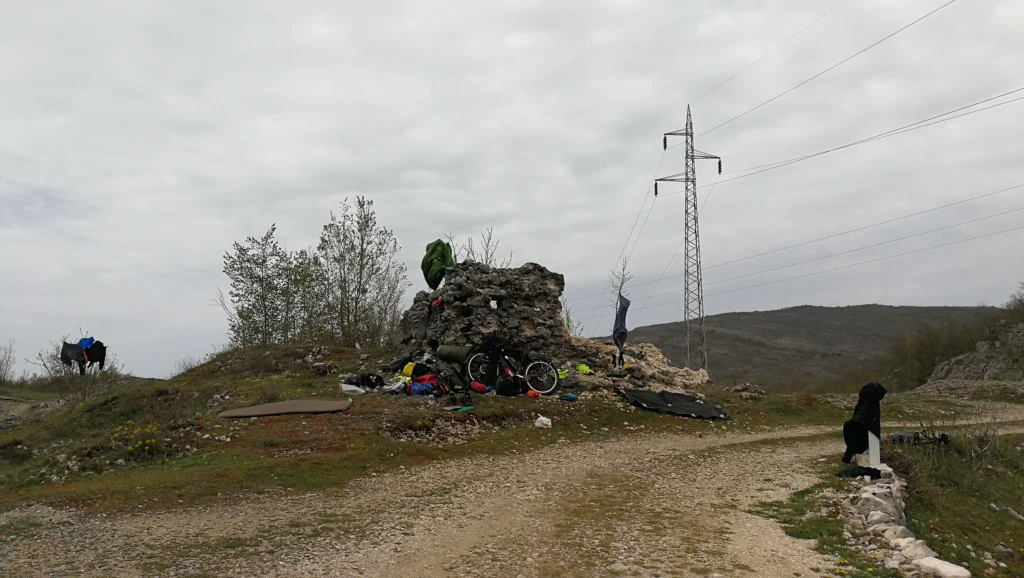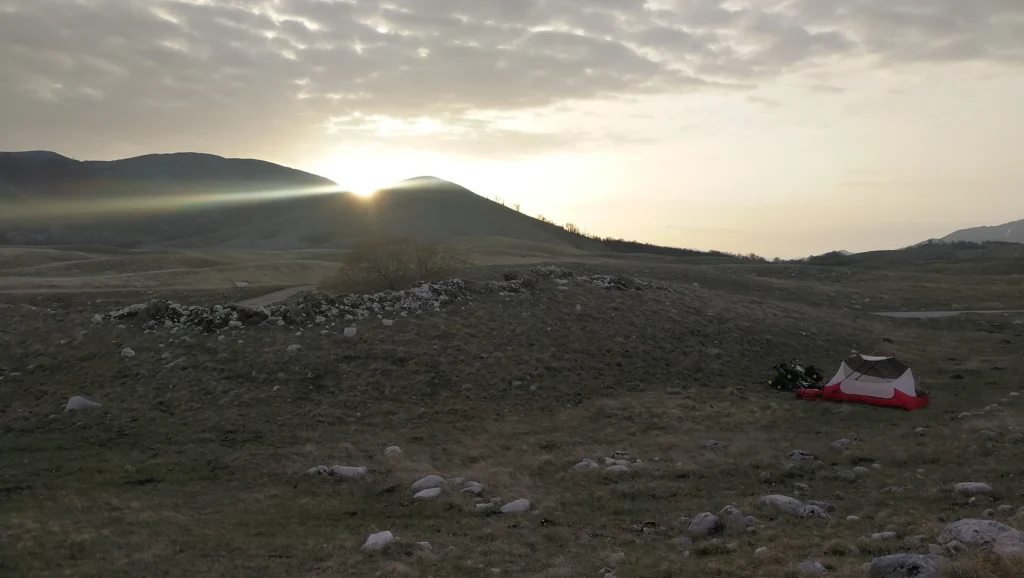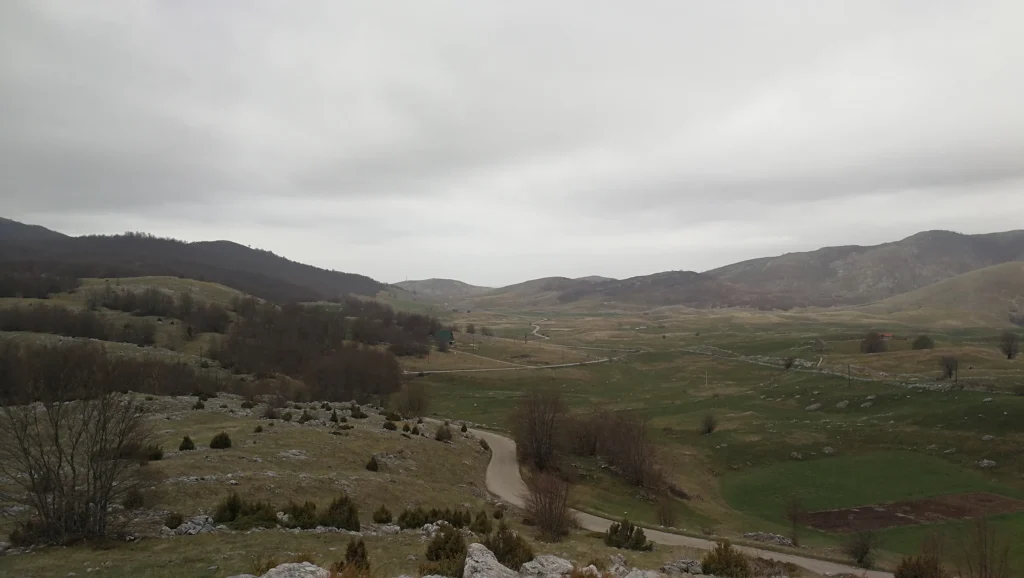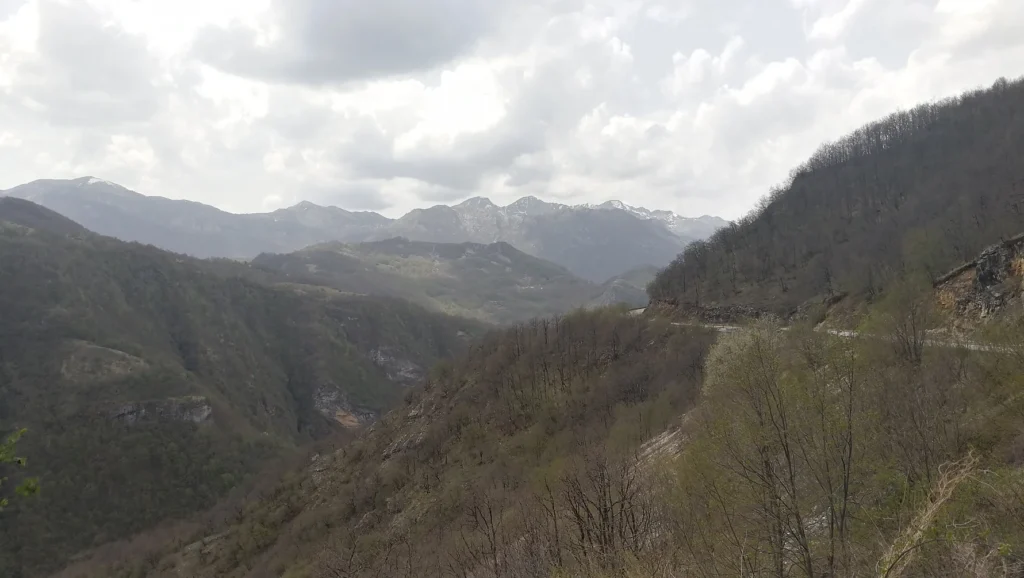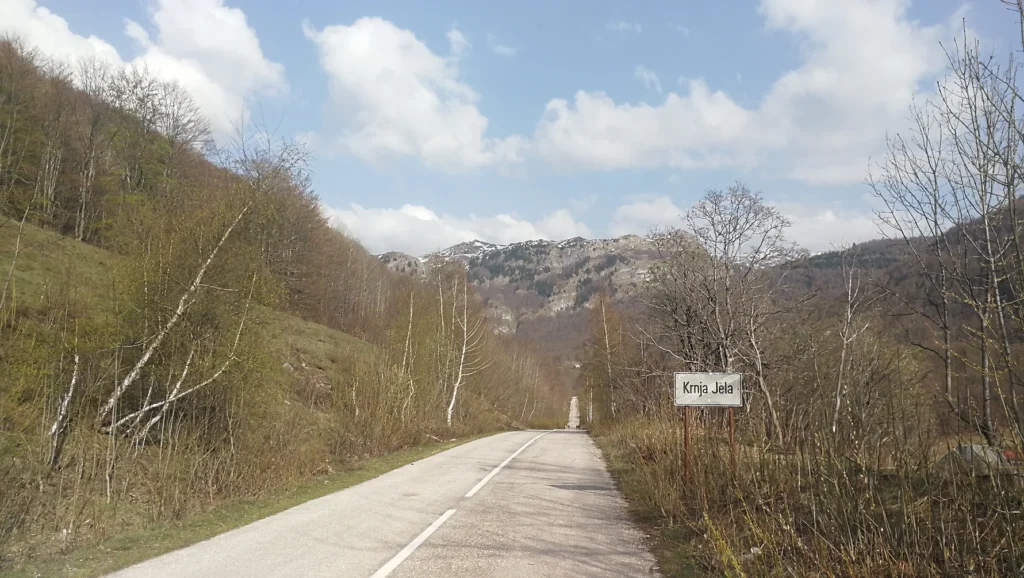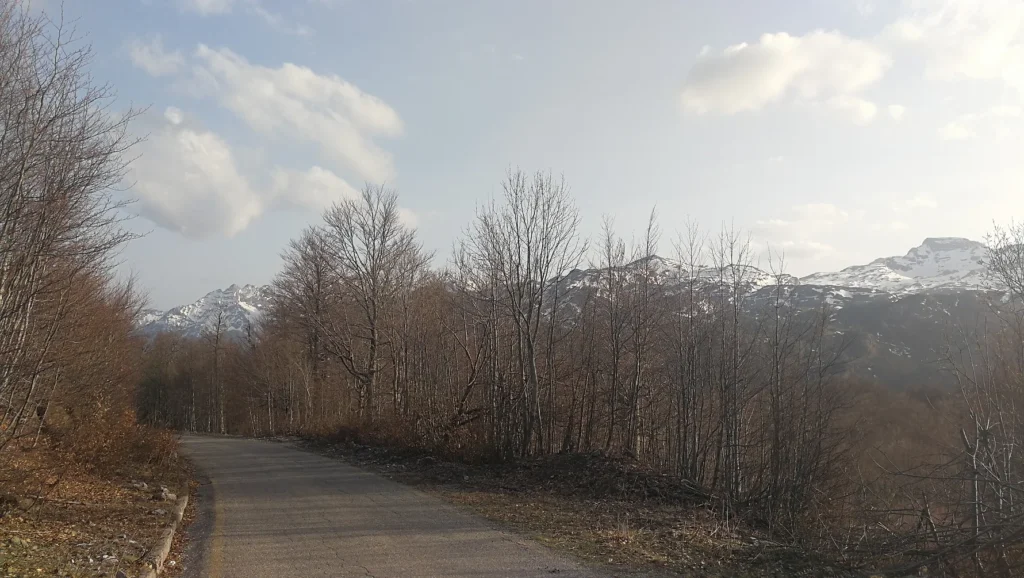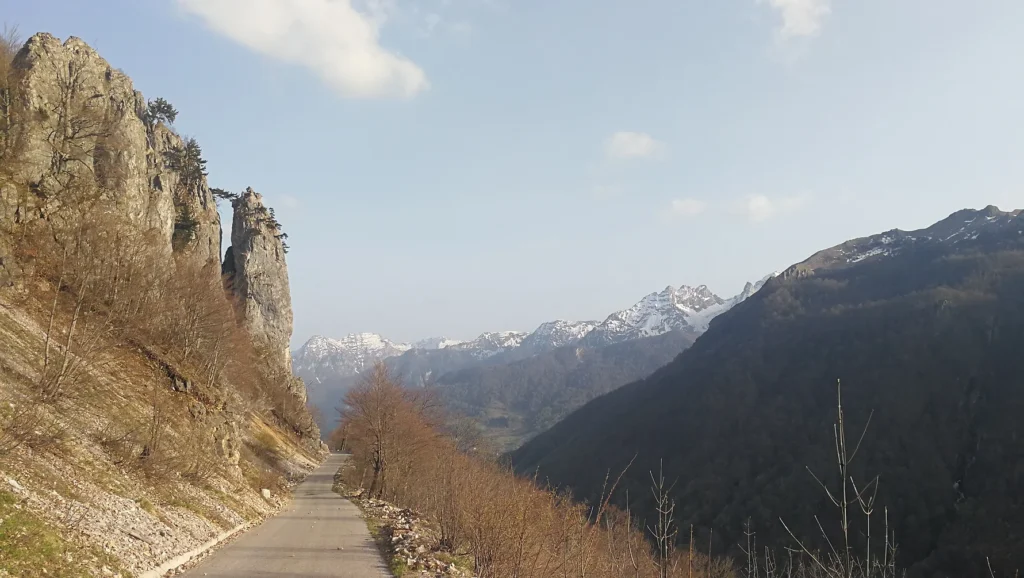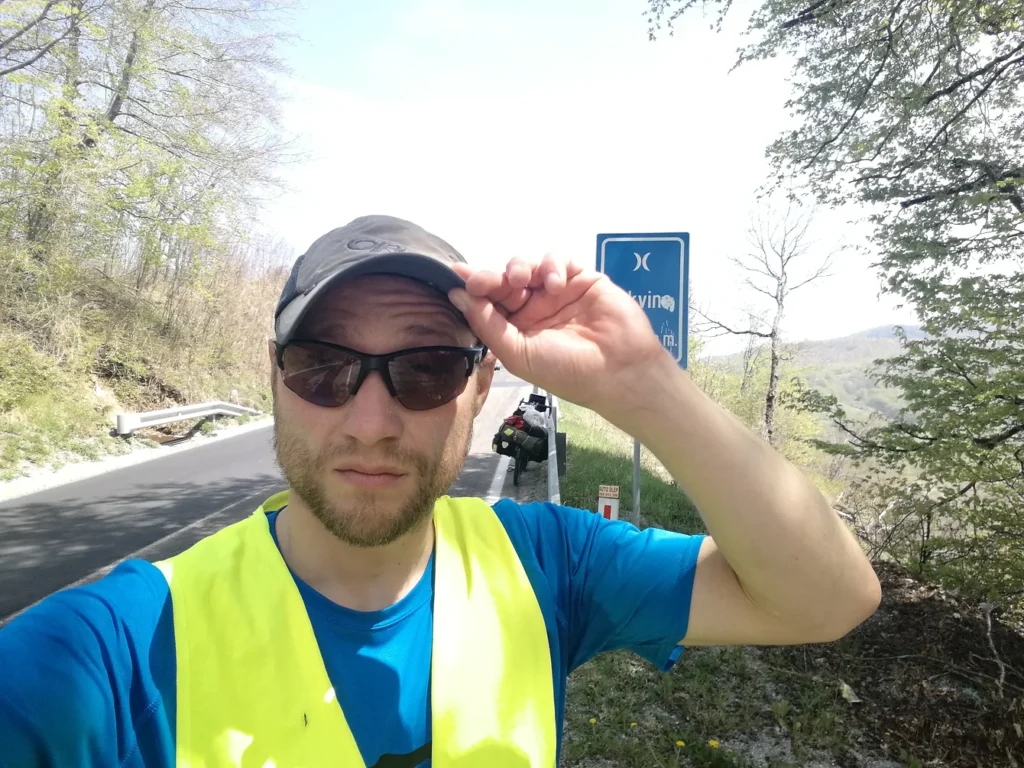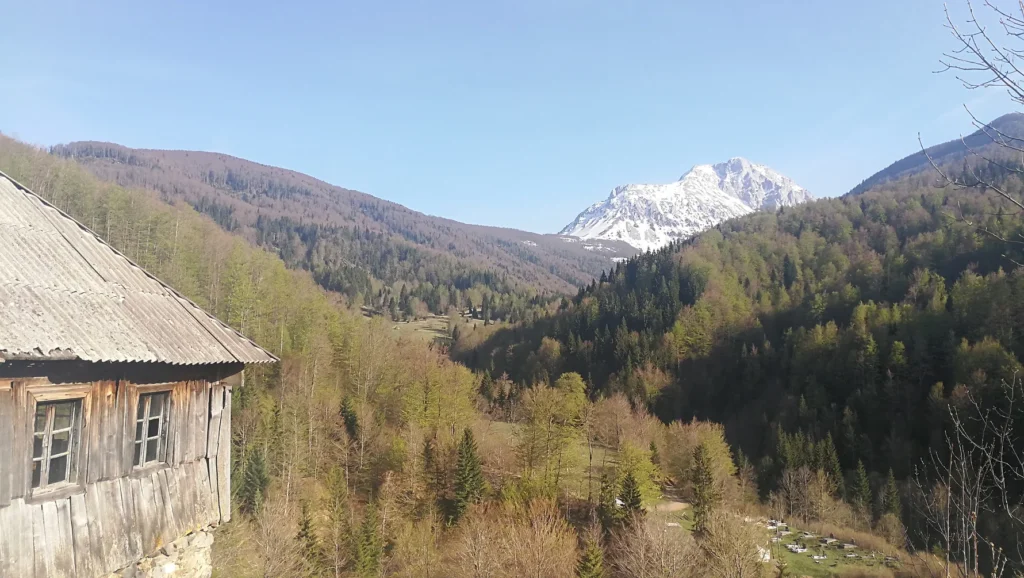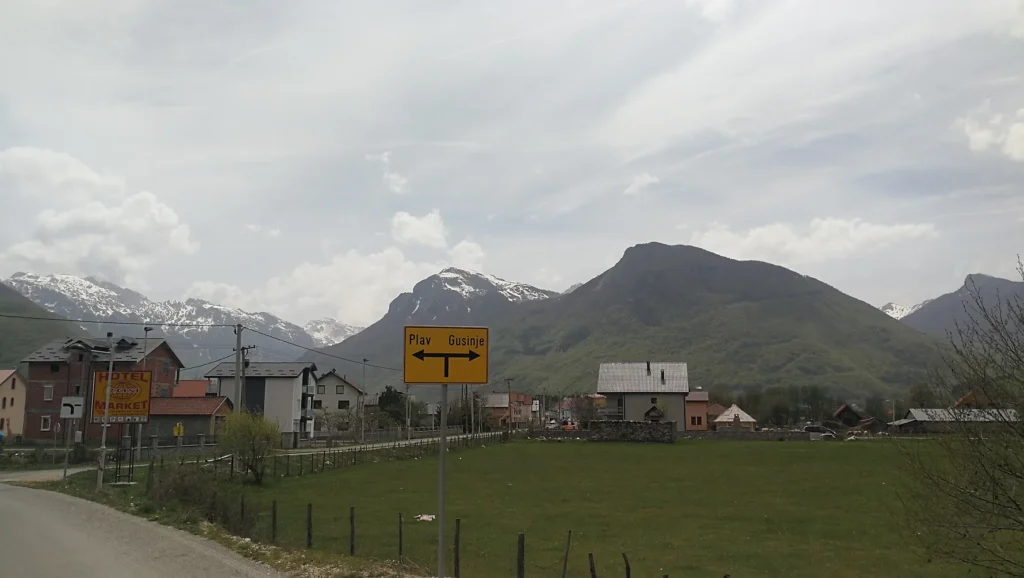Montenegro — Flowing
In the evening I reached the border crossing between Bosnia-and-Herzegovina and Montenegro at 1,000 meter elevation. It had 4°C and I immediately changed into dry thermal underwear.
Montenegro, black mountain, a well-chosen name for this country on first impression.
After the border I rode a short downhill but with the sunset coming I pitched camp at the first opportunity before it got dark.
Montenegro, today a country of 620,000 inhabitants, has seen its fair share of change over the course of history.
Politically, over the last centuries Montenegro was a kingdom, was ruled by the Ottoman empire, was part of the Socialist Federal Republic of Yugoslavia, and formed a federation with Serbia. In 2006 Montenegro declared its political independence and dissolved the federation after a national referendum.
Montenegro is actively working towards becoming a member of the European Union and became a NATO member in 2017. Countries seem to strive both for independence and unity at the same time which the EU’s “United in diversity” culture fully supports.
Religiously, the Montenegrin Orthodox Church was formed in 1993 splitting up from the Serbian Orthodox Church. Since 2019 there are heated debates whether assets such as properties and buildings should be transferred from the Serbian Orthodox Church to the Montenegrin state. In September 2021 there were violent clashes given the inauguration of a new head of the Serbian Orthodox Church in a monastery in Montenegro.
Countries of course don’t act themselves but rather individual humans. Statements such as “Montenegro declared its political independence” or “Montenegro works actively towards EU membership” are simplifications.
In reality, groups of humans with a certain country affiliation (such as a passport) and with heterogeneous individual views on the social, political, economic, military, religious and cultural parts of “their” country work together with a mix of dialogue, compromise, and sometimes violence. A country searching its soul means more precisely that heterogeneous humans are searching for their national, ethnic, and religious identity – individual humans like you and me.
The psychoanalyst Carl Jung made a strong argument for our individuality in the face of modern societies dominated by the state, and emphasized:
“Happiness and contentment, equability of soul and meaningfulness of life – these can be experienced only by the individual and not by the State, which, on the one hand, is nothing but a convention of independent individuals and, on the other, continually threatens to paralyze and suppress the individual.”
Dear fellow human reading this, let’s remember something existential: it’s your and my individual consciousness and that of our fellow human brothers and sisters that creates all state behavior. There is no “state” or “system” or “party” or “government” in power anywhere in the world. These terms are just placeholder-words for individual humans collaborating with a free consciousness.
Our individual human consciousness is logically always the only source of creation of states, and the only force shaping our society no matter the superficial political system which comes and goes while we, as free individuals, shape it based on what feels right. It’s the same with the placeholder-word “military” – its only source of creation is our individual human consciousness.
In the morning I cycled towards Nikšić, Montenegro’s second-largest city with about 60,000 inhabitants. That’s 60,000 individual and free humans creating their state and shaping their society as it feels right to them – 60,000 existentially free consciousnesses forming one united power in diversity.
I stopped when the sun came out to dry out my equipment which got soaked yesterday.
A family on a bike tour came by and I was really happy to meet those true adventure cyclists.
Coming from Bosnia, some kilometers before Nikšić you pass Slano Lake – apparently rich in fish.
In Nikšić I bought food for 2 days and then randomly cycled northeast into the mountains assuming that cycling the smallest mountain roads was doable – would they be paved? It turned out I found a pretty chill plateau with nobody around.
Over dinner I thought about consciousness change processes happening over our human life path.
I’m just a cyclist and you, dear reader, know as much about the human consciousness as me. Also here I can just share some subjective speculations with humbleness and uncertainty.
What always interests me beyond individual life stories is the question if there are structural patterns in the consciousness change processes we all go through. Things that generalize.
There is the growing up perspective. As children we all needed nourishment, safety and teachings from others – but as adults we can become independent and detached from external things like the judgment of others – if we choose so.
There is the consciousness expansion perspective. Even after we become biological adults our consciousness keeps evolving until the day we die – is “expansion” a fitting term here?
That’s probably just a matter of linguistic preference … but given that over the phase of our adult life our consciousness generally becomes deeper, our reality perception wider, and our caring for ourself and others more universal, the term “consciousness expansion” seems to fit as a placeholder for the real thing happening inside us.
I mean we all understand our life and reality generally better when we have seen more stuff, right?
And the suffering perspective? To me it seems that suffering and our handling of it is a key aspect of our consciousness journey through life. Harsh conditions is what we all face in our lives, sometimes more tangible, sometimes more subtle. Sometimes visible on the surface of our life, sometimes hidden deep inside our soul.
“Suffering” is just a word, just another verbal placeholder for a reality aspect. It’s a broad term too – depending on our understanding of this word it can comprise all suffering variants experienced by all humans since the beginning of time.
Is suffering something positive or negative? Here things get interesting. A common association with the word is that it is something negative, something to be avoided. But we are free inside ourselves to cultivate a positive attitude towards our suffering – if we choose so.
In sports science the term “supercompensation” is used to describe that a positively stressed human body grows stronger in the recovery phase following a workout. Trauma therapists observe that post-traumatic growth of personal strength and life appreciation often follows a person’s stroke of fate. And sociologists discuss how societies can become modernized after wars.
Of course we cannot “think away” our given suffering and life can be painful and cruel – sometimes life even serves us genocides or catastrophes of global scale. But every suffering we experience in our consciousness is also an opportunity-to-grow as we all have the existential freedom and power to choose our attitude regarding our “suffering handling”. Why not?
And who knows, perhaps this attitude shapes the consciousness change processes happening over our life path more than anything else.
In the morning I crossed the plateau topping out at 1,400 meter elevation, then I dropped into Šavnik valley to 800 meter elevation, then cycled up again a mountain ridge to 1,600 meter elevation. Sure I could have cycled from Berlin to Istanbul all the way on a flat course along the Adriatic coast but what would the mountains look like in the inner Balkans?
The downhill brought me back to civilization. It’s always better to have your own food given that markets and restaurants can be closed in areas like this.
The Greek philosopher Heraclitus observed 2,500 years ago:
“Panta Rhei” – everything flows.
Heraclitus argued it’s impossible to step into the same river twice as the second time both the river and the person stepping into the river have changed. His worldview, of course, was much deeper than an analysis of the metaphorical river.
What Heraclitus meant was the way things exist in general – that the whole reality we perceive in our consciousness exists in flux.
There is the body perspective. We are all a fluid cell pile over time – eating, installing molecules from our food in our organs, defecating and urinating, shedding old skin cells. Possibly we reproduce our DNA during our lifetime and see a baby grow up.
There is the constant evolvement perspective. In our individual development there is no finish line when we become an adult. From our birth to our death we remain a constantly evolving biological organism, constantly stimulated by our senses, constantly reacting and making decisions, and constantly gaining life experience.
Of course here is the larger consciousness perspective. How do our reality and consciousness work in general?
Who knows … but we all seem to exist as a fluid individual consciousness over time – inside us, we have constantly changing feelings, thoughts, and assumptions about who we are in a world that is also changing constantly.
I’m not sure if we should think so much about consciousness change processes happening over our human life path. Because the more we “think” about our path, the less we feel it. Perhaps searching for “structural patterns” in the consciousness change processes we all go through is a really dumb idea …
On the other side, some thoughts on consciousness change processes happening over our human life path may actually be helpful for deeper and fuller consciousness exploration – until a certain degree of escalation is reached.
I guess some sort of balance inside us is a healthy way to go forward … kind of a parallel and integrated feeling-thinking-existing – something we directly are out of our raw being.
We flow in it.
After Šavnik I cycled up the R18 road eastbound. Pretty aggressive serpentine slopes in the beginning but then the road eased into a nice mountain flank overlooking the Bukovica river valley
A cycled though a pitch-black tunnel but given zero traffic on this road it was fun.
While cycling meditation generally works well, some foresight is beneficial as there can always be stones on the road.
How do stones on our life path shape our consciousness?
I truly believe stones in all their forms are an exciting training opportunity – stones are our friend.
We could discuss a million ways stones on our life path are good for us, here are just some associations which came to my mind:
First, each stone invites us to make a free and powerful decision on the values we stand for. Self-reflecting on our individual values is a good start to live authentic … but it’s our decisions and actions when handling life’s stones which truly reflect the values we live by – everything else is just talking inside.
Which values do you want your actions to reflect when life serves you stones?
Second, each stone invites us to overcome roles. When life throws a challenge in our path, we can listen and feel inside us and then act aligned with who we really are … instead of playing a role.
Which actions feel true to who you really are when you handle stones?
Third, each stone invites us to develop our character – our constant handling of the stream of stones in our life shapes who we are … who we become.
You are powerful and free – the choice is always yours when you handle stones:
Do you want to be strong or weak?
Do you want to be proud or ashamed?
Do you want to cultivate forgiveness or revenge?
Do you want to life with grace or with a bad style?
Do you want to live life feeling free or feeling like a slave?
Do you want to act with self-love and compassion or with anger and hate?
“Blockades”, “suffering”, “pain”, “opportunities” … on the one side, these are just placeholder words for the real stones in our life. On the other side, on our internal consciousness gym we get fit when we practice – and for that our chosen self-reflection terminology matters … so pick wisely.
Without being challenged and stimulated through stones on our path, how would we develop wisdom and strength?
And despite all stones and pain, life is fair. Sometimes we simply roll effortlessly over smooth tarmac and enjoy the mountain scenery of life with a smile.
One aspect of life is that we are all in the same boat. We all follow individual and unique life paths and the color and form of our stones differ – but the fact that we face stones is something you and I share universally with all other humans on earth.
And while solitude and meditation bring us clarity on our path, I believe sometimes we need to be social and spend time with other people. Yes functionally too, like to be mirrored, having dialogues, cultivating reciprocal self-reflection and all that. But sometimes just to get loose and have some fun together.
I asked I gentleman in his weekend mountain house for water and got self-made cheese, bacon, and schnapps – lots of schnapps. I chatted with him and his family for two hours using the Google Translate App. Thank you very much my friends – Hvala vam!
How do we learn in life to judge between good and evil?
I would say automatically by simply living our life with open eyes. Trusting people, making experiences, accepting and handling the stones on our path, things like that.
In my view, the art of judging between good and evil has layers. For example, there is the superficial layer of things we directly see with our eyes (e.g. “the snake”) but there are also deeper layers of what we feel inside (e.g. “she is an indicator of a functioning ecosystem and I like that”).
In the evening I cycled up a pass of 1,600 meter elevation but wasn’t sure if I could make it over before sunset.
I pushed myself and reached the pass with one hour of daylight left.
I rolled downhill with a smile and pitched camp next to a small mountain creek. This day had been one of those cycling days with so many impressions that I felt like I had been on the road for a really long time.
So what about the why? What about the overall purpose of our life?
On a micro level of self-reflection, we can look at individual stones on our path and how we handle them. We can listen inside ourself, feel what our own values are, and then act in each situation in an authentic manner. And we could do this all life long without ever asking for the “why” – just going with the flow.
But what if we want to live deeper?
On a macro level of self-reflection, fundamentally larger questions are waiting for us. Does our path have an overall purpose? Why do we humans do all this, accepting our pain, stumbling forward with a blurry vision where we are going, searching inside ourselves for truth?
The life energy driving us perpetually forward through all stones of all times … the whole thing kind of flows.
Today brought several passes, about 2,500 meter elevation cycled uphill in total. If you love mountains come to the inner Balkans and you will not be disappointed.
In the morning a teenage boy on the roadside threw a stick at me with pure hate in his eyes. It looked like this was more his general outlook on life than something personal towards me and he also missed, but still I didn’t like the energy at all.
As soon as I left the R18 road and joined the E65 I suddenly rode in dense traffic. Before reaching a pass I had to cycle through several uphill tunnels without a shoulder while being closely passed by speedy traffic. I didn’t like the situation at all and was glad when I reached the pass and got out.
I restocked food in Kolasin and then cycled east on a small mountain road towards Andrijevica. On this stretch I saw few people but lots of poverty – people battling uphill in their lives with subsistence farming and manual charcoal production. This area felt like it has been left behind.
Zero traffic on the M9 road, challenging afternoon pass but worth the scenery cycling north of the Komovi mountain range.
This was a tough day in the saddle. I got a hotel room in Andrijevica.
In the morning I rode via Plav and Gusinje towards the Albanian border. I didn’t know much about that stretch – in Kolasin I had asked locals but they didn’t even know about the border crossing’s existence.

No need to rush to the border – I left the road for an hour to check out the small town Plav. It’s situated at the shore of a glacial lake formed roughly 10,000 years ago at the end of the last ice age. Pretty laid-back feeling.
Perhaps life’s meaning was not so complicated.
If we like it or not, we do exist now, and we do breathe now, and we do experience pain and joy in our consciousness now.
So why not just make the best it?
No need to rush to the border – I left the road for another hour to check out Gusinje, the last small town before the border crossing. Gusinje has a mosque with a wooden minaret and also a pretty laid-back feeling.
How will the mountains in Albania look like? Breathing in, breathing out – life feels good!
Montenegro, your rivers and stones have been inspirational – thank you for the flow. Whatever our further consciousness expedition will bring, perhaps it’s a good idea to always remember that our path flows through us … or maybe we shouldn’t “remember” and just feel it.


